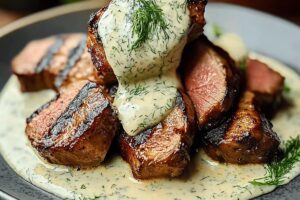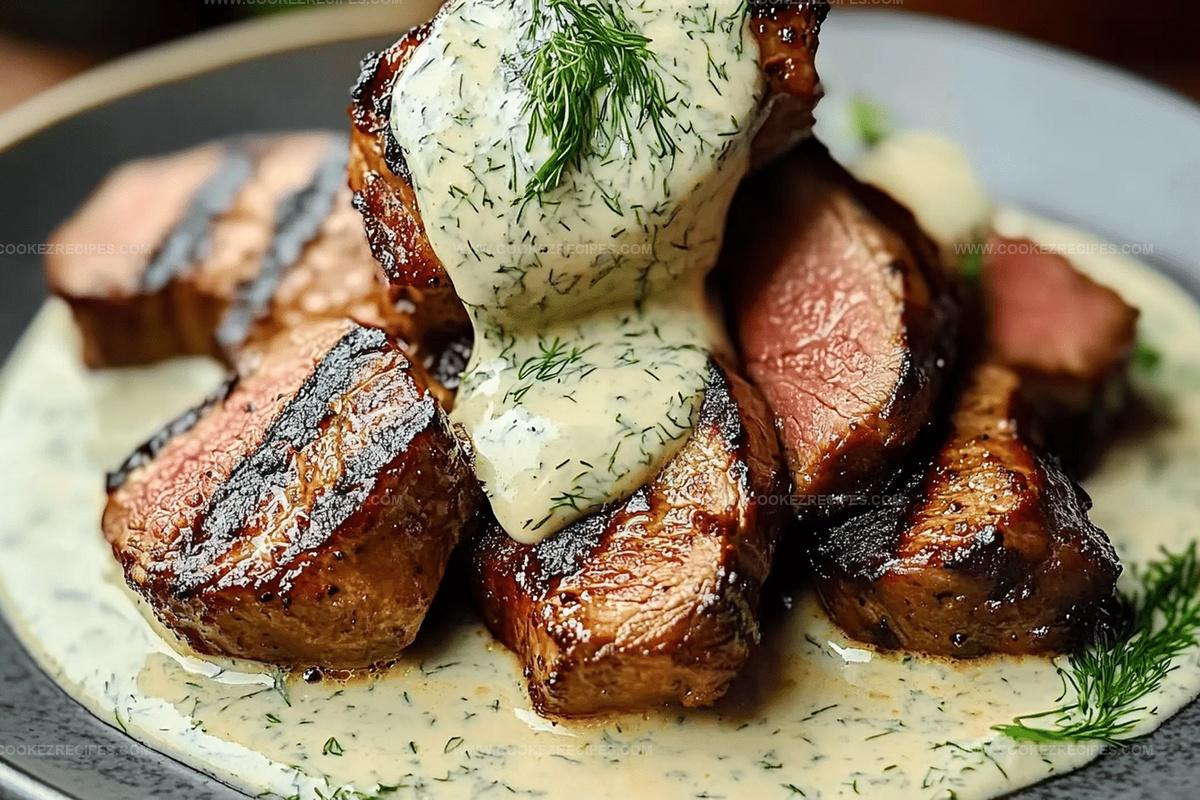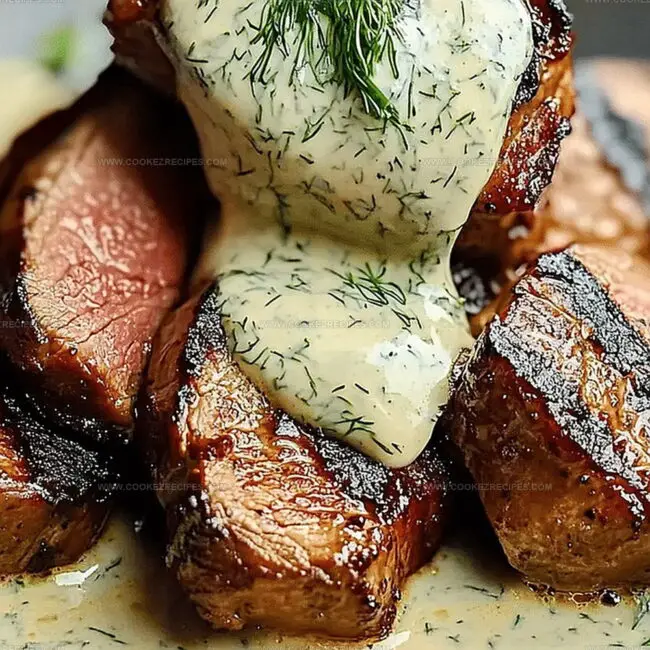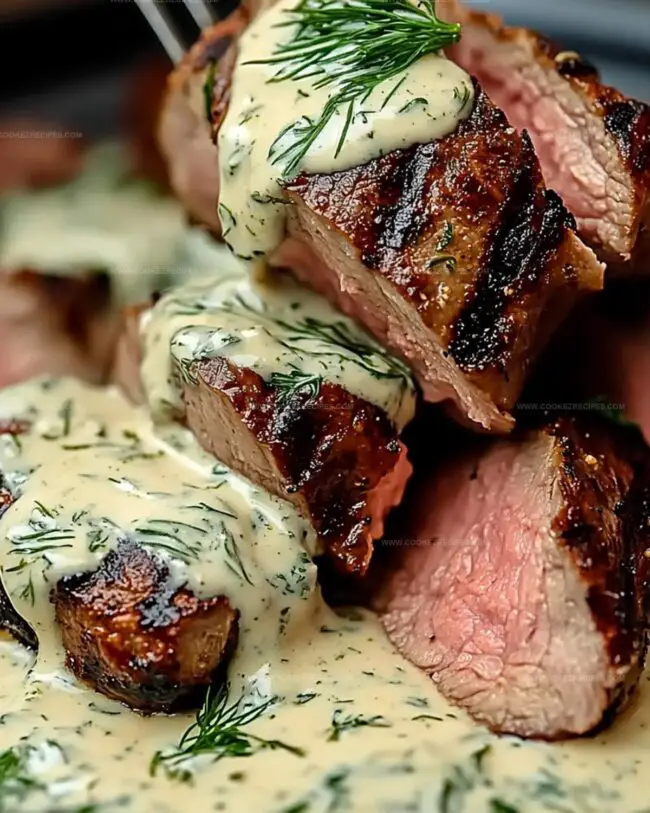Juicy Grilled Tenderloin with Dill: A Flavor-Packed Recipe
A perfectly seasoned grilled tenderloin with dill can turn an ordinary dinner into a culinary adventure.
Juicy meat calls for bold flavors and precise cooking techniques.
Herbs like dill bring unexpected brightness to classic protein preparations.
Summer evenings beg for outdoor grilling and spectacular main courses.
Tender cuts deserve careful attention and creative marinades.
Subtle herb infusions make ordinary meals memorable.
This recipe will spark your confidence in preparing restaurant-quality dishes at home.
Grilled Tenderloin With Dill That Elevates Dinner
Essentials in Tenderloin with Dill
Main Protein:Seasoning and Marinade:Dill Sauce Components:Grilling Guide for Tenderloin with Dill
Step 1: Massage Tenderloin with Flavor
Lovingly coat the tenderloin with a generous drizzle of olive oil.
Sprinkle a harmonious blend of:Finish with a bright splash of fresh lemon juice, allowing the citrus to dance across the meat’s surface.
Step 2: Fire Up the Grill
Ignite your grill to a sizzling medium-high temperature.
Let the grates heat up until they’re radiantly hot, creating the perfect canvas for a beautifully caramelized exterior.
Step 3: Sear and Grill with Precision
Carefully place the tenderloin onto the heated grates.
Let it sizzle and develop a gorgeous golden-brown crust.
Grill for 4-6 minutes on each side, watching for that perfect golden color.
Use a meat thermometer to check for 145°F (medium-rare) or adjust to your preferred doneness.
Step 4: Whip Up Creamy Dill Companion
In a mixing bowl, create a luxurious sauce by combining:Blend until silky and well-incorporated.
Season with a pinch of salt and pepper to elevate the flavors.
Step 5: Rest, Slice, and Celebrate
Allow the grilled tenderloin to rest for 5 magical minutes, letting the juices redistribute.
Slice into elegant medallions that showcase the meat’s perfect cook.
Drizzle the creamy dill sauce over the top or serve it on the side for dipping.
Enjoy your culinary masterpiece!
Tenderloin Grilling Best Practices
Tenderloin That Tastes Right The Next Day
Best Matches For Tenderloin
Dill Tenderloin Seasoning Switches
FAQs
Use a meat thermometer to check the internal temperature. For medium-rare, aim for 145°F (63°C). The meat should feel slightly firm with a touch of springiness when pressed.
Yes, you can make the dill sauce up to 24 hours before serving. Store it covered in the refrigerator. The flavors will actually develop and become more robust as it sits.
Both gas and charcoal grills work well. The key is maintaining a consistent medium-high heat and creating those beautiful sear marks on the tenderloin.
Always let the tenderloin rest for 5 minutes after grilling. This allows the juices to redistribute throughout the meat, ensuring a tender and flavorful result.
Print
Grilled Tenderloin with Dill Recipe
- Total Time: 25 minutes
- Yield: 4 1x
Description
Succulent grilled tenderloin with dill brings Mediterranean elegance to your dinner table. Herbal notes and perfectly charred edges promise a memorable culinary experience you’ll savor with each delicious bite.
Ingredients
Main Ingredients:
- 1.5 pounds (680 grams) tenderloin, trimmed
- 1/2 cup (120 milliliters) mayonnaise
- 1/4 cup (60 milliliters) sour cream
- 2 tablespoons fresh dill, chopped
Seasoning Ingredients:
- 1 tablespoon olive oil
- 1 lemon, juiced
- 2 cloves garlic, minced
- 1/2 teaspoon salt
- 1/4 teaspoon black pepper
Additional Sauce Ingredients:
- 1 tablespoon lemon juice
- Salt and black pepper, to taste
Instructions
- Prepare the tenderloin by coating it with a light layer of olive oil, ensuring even coverage. Generously sprinkle with freshly ground black pepper, kosher salt, and finely minced garlic. Drizzle fresh lemon juice across the entire surface to enhance flavor and tenderize the meat.
- Ignite the grill and adjust the temperature to a medium-high setting. Allow the grates to heat thoroughly, creating optimal conditions for a perfectly seared exterior while maintaining a juicy interior.
- Carefully position the seasoned tenderloin onto the hot grill grates. Cook for approximately 4-5 minutes on each side, rotating once to create attractive crosshatch grill marks. Monitor the internal temperature, aiming for 145°F for a perfect medium-rare finish.
- During grilling, craft the accompanying dill sauce by whisking together mayonnaise, sour cream, and finely chopped fresh dill. Incorporate a splash of lemon juice and minced garlic, then season with a pinch of salt and pepper. Blend until the mixture achieves a smooth, creamy consistency.
- Once grilling is complete, transfer the tenderloin to a clean cutting board. Allow the meat to rest for 5-7 minutes, which helps redistribute internal juices and ensures maximum tenderness.
- Slice the rested tenderloin into elegant medallions, arranging them artfully on a serving platter. Drizzle the creamy dill sauce alongside or directly over the meat, creating an appetizing presentation that highlights both the grilled protein and its complementary sauce.
Notes
- Allow the tenderloin to reach room temperature before grilling to ensure even cooking and a perfect sear.
- Pat the meat dry with paper towels to remove excess moisture, which helps achieve a beautiful golden-brown crust.
- For a leaner version, swap sour cream with Greek yogurt in the dill sauce to reduce calories and add extra protein.
- Check the meat’s doneness using a meat thermometer for precise results, preventing overcooking and maintaining juicy texture.
- Prep Time: 10 minutes
- Cook Time: 15 minutes
- Category: Dinner
- Method: Grilling
- Cuisine: American
Nutrition
- Serving Size: 4
- Calories: 473
- Sugar: 1 g
- Sodium: 749 mg
- Fat: 34 g
- Saturated Fat: 6 g
- Unsaturated Fat: 24 g
- Trans Fat: 0 g
- Carbohydrates: 7 g
- Fiber: 0 g
- Protein: 36 g
- Cholesterol: 103 mg





Daniel Bruns
Founder & Culinary Innovator
Expertise
Recipe development for home cooks, Nutritional analysis and meal planning, Culinary education and food writing
Education
Auguste Escoffier School of Culinary Arts
Diploma in Culinary Arts and Operations
Focus: Classical and contemporary cooking techniques, Culinary entrepreneurship and kitchen management, Menu development and food cost analysis
Daniel’s story started with flour on his face and a pie in the oven at his grandma’s house. He later sharpened his skills at the Auguste Escoffier School of Culinary Arts.
His goal? Recipes so simple you’ll want to cook every night. When he’s not whipping up one-pan wonders, Daniel’s outside picking herbs, hosting neighborhood cook-offs, or baking chocolate cakes with his kids, messy, sweet, and unforgettable.